Columnist Paul goes comic-book channel surfing…
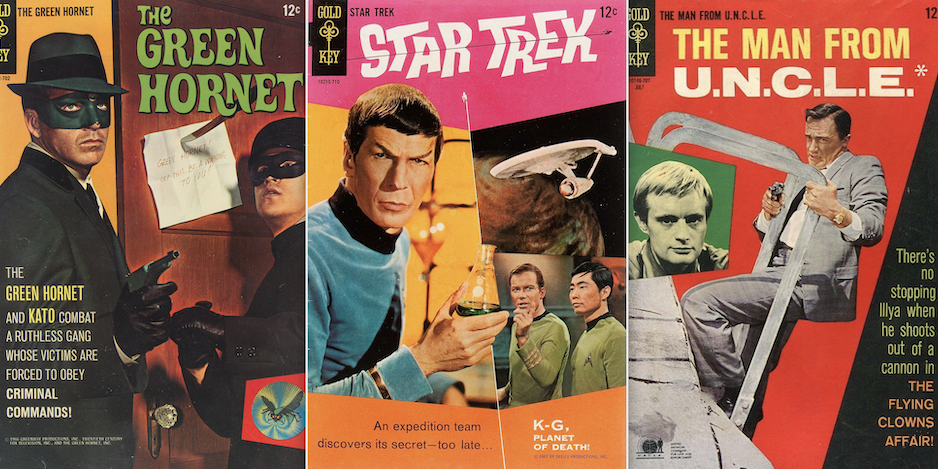
—
By PAUL KUPPERBERG
Despite my irrational childhood love for Jerry Lewis, I somehow missed out on the DC Comics-published Adventures of Jerry Lewis comic book (#41-#124 between 1957 and 1971; the first 40 issues were the Adventures of Dean Martin and Jerry Lewis, but Jerry got the comic book in the divorce) until the last few issues in 1971. I suppose it was a matter of distribution or something, because I certainly didn’t shy away from comic book movie and television adaptations.
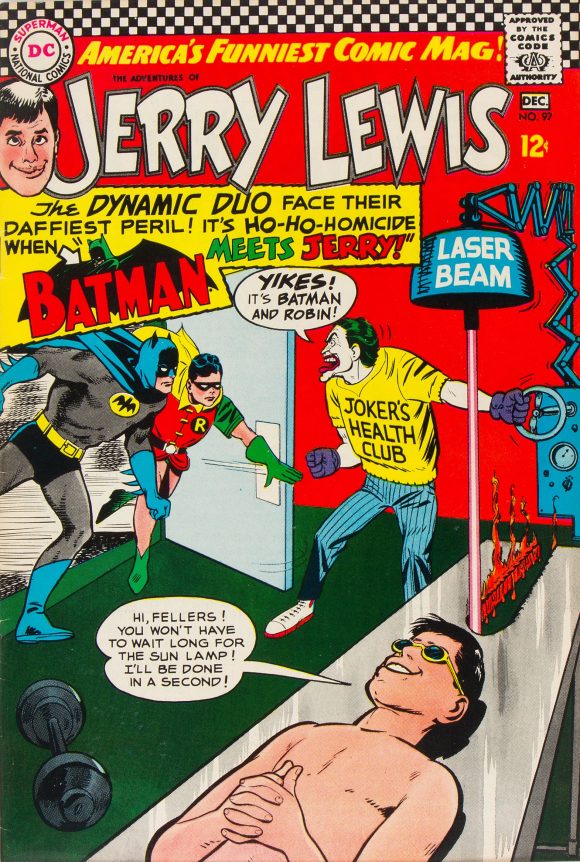
In fact, the 1960s was a kind of Golden Age of comic book movie and television adaptations, with Dell and Gold Key especially licensing just about anything and everything based on the latest TV shows; dramas, sitcoms and animation. I’m guessing licenses were cheap in those days; there was also an explosion of TV show novelizations of many of the same properties appearing in comics (many using the same publicity stills for covers). And, like the shows they were based on, most of these comics didn’t last very long, some only a couple or three issues.
Again, maybe it was a distribution thing or maybe it was that they licensed more of the shows I liked, or maybe it was all those amazing George Wilson covers (they later went over to photographic covers) but my strongest memories are of the Gold Key comics.
Here are MY 13 FAVORITE 1960s GOLD KEY COMICS TV ADAPTATIONS, in no specific order:
—
The Man From U.N.C.L.E. #13 (July 1967). In 1965 there was nothing cooler on TV than The Man from U.N.C.L.E., starring Robert Vaughn and David McCallum as partners in espionage for the United Network Command for Law and Enforcement, but only because Batman wouldn’t hit the airwaves until 1966. But even after the advent of the live-action adventures of the Dynamic Duo, Napoleon Solo and Illya Kuryakin were still dynamic enough to hold their own.
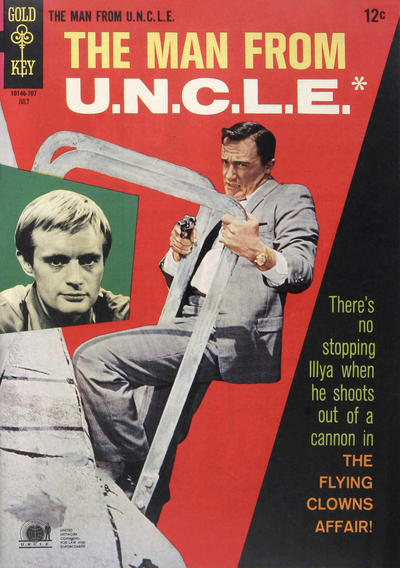
Because of the cool factor, The Man from U.N.C.L.E. was probably one of the earliest TV adaptations I ever picked up from the newsstand. But while I came for the coolness, I was hooked by the art. I was learning to identify the styles of the artists of my favorite comics, even if I didn’t know their names. “The Flying Clowns Affair” happened to have been penciled by an artist whose name I did know, because he was credited in every issue of a fave, DC’s Justice League of America: Mike Sekowsky.
The Man from U.N.C.L.E. lasted 22 issues (May 1965-April 1969), ending along with the TV series.
—
Star Trek #1 (Oct. 1967). I always kind of wished the guys who drew the Star Trek comic had designed the TV show as well. The interiors of the Enterprise were way more elegantly futuristic than the squared-off plywood boxes of the show, and they dressed members of landing parties in cool jumpsuits. The stories by Dick Wood, John David Warner, George Kashdan, Len Wein and others were, as I recall, mostly solid, and the art by talents such as Nevio Zeccara, Alberto Giolitti and Alden McWilliams elevated the title above the standard Gold Key licensed fare. The attention to quality paid off; Star Trek ran for 61 issues between 1967 and 1979, outliving the show by more than a decade.
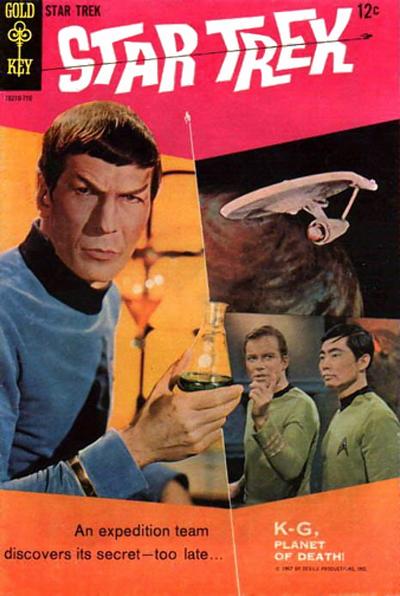
—
The Three Stooges #44 (Sept. 1969). The Three Stooges were a TV viewing ritual when I was growing up. The Three Stooges Clubhouse, hosted by Officer Joe Bolton on New York’s WPIX-TV (Channel 11), was on every weekday afternoon after school, in the same block as the perpetual reruns of the Adventures of Superman. They were among my earliest, if not the earliest, comedy influences. The first movie I ever saw in a theater was their 1959 “science fiction” comedy, Have Rocket, Will Travel.
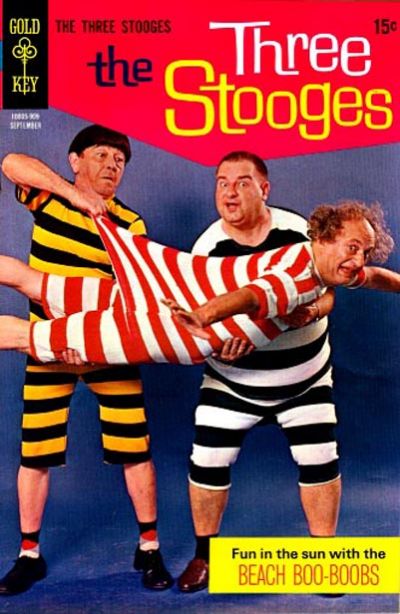
Of course, the Gold Key version suffered (like Have Rocket, Will Travel) by the absence of either of the two acceptable third stooges, Shemp or Curly. (I’m a Curly man myself, but I appreciate what Shemp brought to the dynamic, and I don’t judge the personalities of others by their choice.) Still, I was fanatic enough to grit my teeth and accept Curly Joe DeRita, that boidbrain!
—
Checkmate #1 (Oct. 1962). I admit it; I didn’t know this one existed until the 1980s when I created and wrote a comic titled Checkmate for DC Comics. I think I was only vaguely aware of the show itself (an Eric Ambler-created series about a San Francisco detective agency by that name, two seasons starting in 1960 on CBS, starring Anthony George, Doug McClure, and Sebastian Cabot).
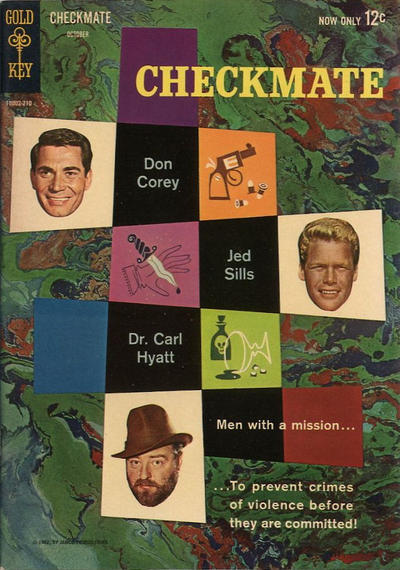
Though nicely written by the ubiquitous Paul S. Newman, a contender for most prolific comic book writer of all time, and well drawn by artist Jack Sparling, Checkmate only lasted two issues.
—
Supercar #1 (Nov. 1962). I loved the syndicated Supercar so much as a kid that I refuse to watch any of the old episodes because I just know they won’t live up to my memories. Supercar was imported from England, Gerry Anderson’s first Supermarionation TV series (1961-62), which also had a kickass theme song, as Anderson’s shows tended to feature about pilot Mike Mercury and the amazing Supercar that could go anywhere. Courtesy of writer Newman and artist Ray Osrin, the Supercar comic was short-lived — but lives on in my heart.
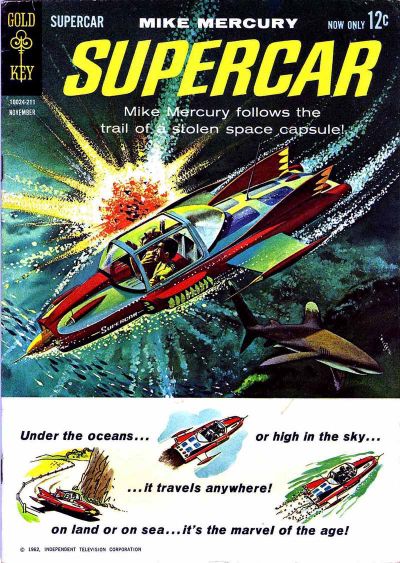
—
The Time Tunnel #2 (July 1967). The Time Tunnel was a one- season Irwin Allen science-fiction show (30 episodes, starting in 1966) that lasted a lot longer in viewers’ memories than it did on the air. The premise was simple; two scientists forced to tumble through time and influence events (they landed on the Titanic in 1912 in the first episode) until their compatriots at the time traveling Project Tic-Toc can bring them safely back to their own time. Twenty-plus years later, Donald Bellisario would be more successful with the premise, calling it Quantum Leap, but instead of Dean Stockwell holding down home base, Time Tunnel had Lee Meriwether. The two issues featured George Wilson covers, scripts by Newman, and art by Tom Gill.
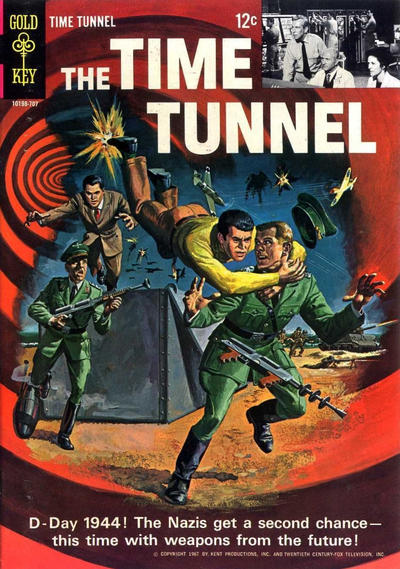
—
The Green Hornet #1 (Feb. 1967). Producer William Dozier followed up his hit Batman series on ABC later in 1966 with another masked crime fighter and sidekick, the Green Hornet and Kato. Based on the classic radio program (1936-1952), the Green Hornet and his partner were veterans of comic books (and comic strips) since 1940, but this version was based on the Van Williams and Bruce Lee-starring series, whose photographs adorned the covers. The big draw of this three-issue run, though, was the interior art by Dan Spiegle.
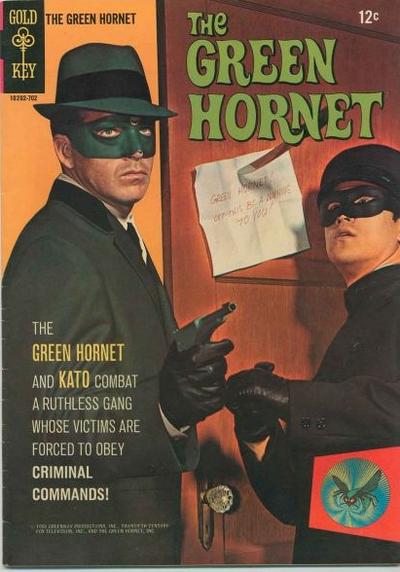
—
The Governor and J.J. #1 (Feb. 1970). Further proof that licensing TV shows must have been insanely cheap. The Governor and J.J. starred Dan Dailey as widower Gov. William Drinkwater and Julie Sommars as his wacky teenage daughter J.J. and lasted two seasons on CBS and three issues of the Gold Key comic by writer Newman and veteran humor artist Henry Scarpelli. It’s hard to imagine selling that premise as a comic-book series these days (it’s also hard to imagine that the show won a Golden Globe for Sommars), but Gold Key’s throw-anything-against-the-wall-and-see-what-sticks approach continued.
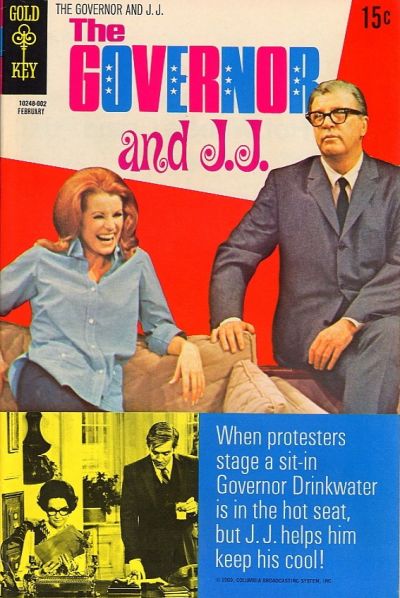
—
The Twilight Zone #12 (Aug. 1965). Another Gold Key adaptation that proved it had legs was Rod Serling’s The Twilight Zone (based on the 1959-64 show), which ran over 90 issues. Squeaky clean Gold Key wasn’t a signatory to the Comics Code Authority — like Dell Comics, their in-house “rules” were stricter than the Code’s — but what the stories in this anthology title lacked in grim and gritty, they more than made up for with brilliant covers by George Wilson and stories and art by top talent, including Joe Orlando, Al Williamson, Don Heck, Joe Certa, Leo Dorfman and others.
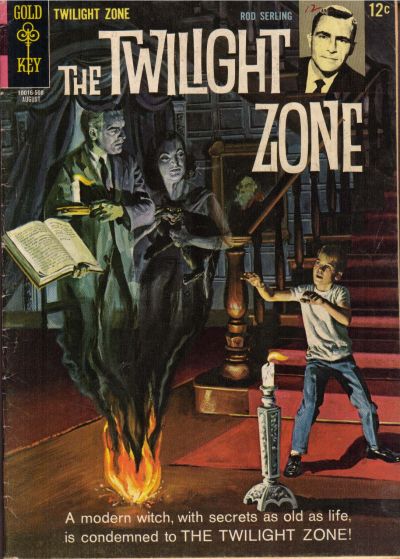
—
The Lucy Show #3 (March 1964). There was a time in this country when we all loved Lucy. We couldn’t help ourselves. She was just so wacky and adorably red-headed. But there would come a time when she’d kick Ricky out, take over the studio, and greenlight Star Trek… which is neither here nor there. Because she also starred in The Lucy Show, which lasted for 156 episodes over six seasons (1962-68) on CBS, and that was a tough pill to swallow. We watched because she was still Lucy, but… yeah, anyway, while it wasn’t as bad as her later (and last) effort, 1986’s Life with Lucy (which I called “Sit Down Before You Break a Hip, Lucy”), it wasn’t comic-book material. Gold Key’s The Lucy Show lasted five issues in 1963-64. Oh, Ricky!
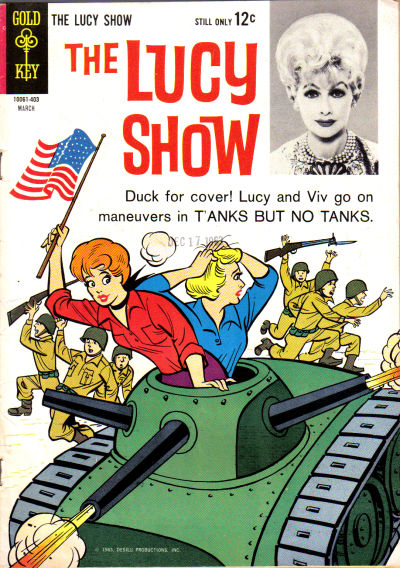
—
Captain Nice #1 (Nov. 1967). Before he was John Adams in 1776… before he was Dr. Mark Craig on St. Elsewhere… before he was K.I.T.T. on Knight Rider, William Daniels was… Captain Nice? Captain Nice was CBS’ 1967 sitcom “response” to Batman (NBC would come out with Mister Terrific, which aired opposite Captain Nice) and was created by writer Buck Henry, the co-creator of Get Smart (with Mel Brooks) and screenwriter of The Graduate and Catch-22.
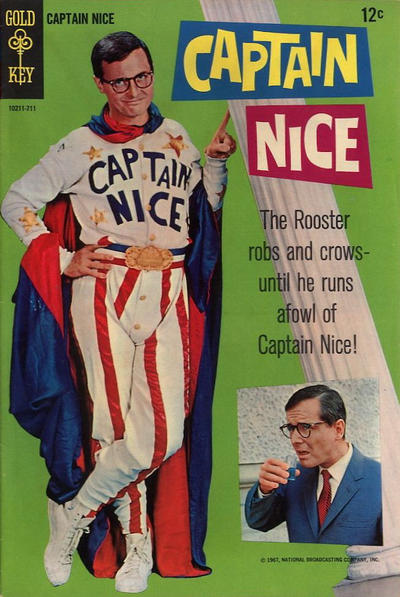
It co-starred the insanely talented Alice Ghostley and Liam Dunn. But none of that could save Captain Nice, which aired only 15 episodes and produced a single photo-cover issue of the comic. Still, it did leave behind a classic Vic Mizzy theme song:
“Look! It’s the man who flies around like an eagle.
Look! It’s the enemy of all that’s illegal.
Look! At the muscles on those arms, they’re like hammers.
Look! It’s the nut who walks around in pajamas.
That’s no nut boy, that’s Captain Nice.
Nice! Nice! Nice! Nice! Nice!”
—
Dark Shadows #3 (March 1969). I didn’t watch Dark Shadows, the gothic horror soap opera that ran weekdays on ABC from 1966 to 1971. It aired afternoons, after school… but it was up against my daily syndicated “Must See TV” shows of the time, especially the Adventures of Superman and The Three Stooges. Also, I was never a big horror fan; aside from the old Universal monster movies, I couldn’t be bothered with that stuff (don’t expect to see my 13 Favorite Hammer Horror Films anytime ever), especially in the mind-numbing, endlessly cheesy soap opera format. But the comic, by Don Arneson and Joe Certa, was one I would pick up on a fairly regular basis; the book ran for 35 issues, from 1969 to 1976.
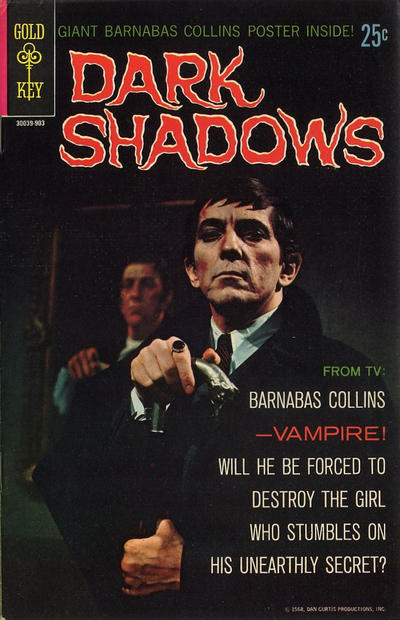
—
Hanna-Barbera Super TV Heroes #3 (Oct. 1968). Back in the olden days, Saturday morning TV was owned by animated series from Warner Bros., Filmation, Sid and Marty Krofft, and, of course, Hanna-Barbera. To help promote their Saturday morning line-ups, Gold Key published seven issues of Hanna-Barbera Super TV Heroes in 1968 and 1969, each issue featuring stories based on such H-B series as Space Ghost, Birdman and the Galaxy Trio, The Herculoids, Moby Dick and Mighty Mightor” (yeah, you read that right), Young Samson and Goliath, Shazzan and others. It wasn’t really superheroes, but it was fun.
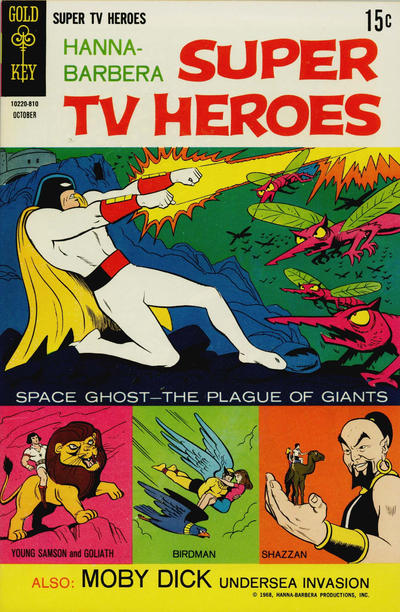
—
MORE
— PAUL KUPPERBERG: My 13 Favorite 1960s MARVEL House Ads. Click here.
— PAUL KUPPERBERG: My 13 Favorite 1960s DC COMICS HOUSE ADS. Click here.
—
Paul Kupperberg has been writing comic books from Archie to Zatanna for 45 years at DC, Archie, Charlton, Marvel, Bongo and others. He is also the author of Paul Kupperberg’s Illustrated Guide to Writing Comics (Charlton Neo Press); I Never Write for the Money… But I Always Turn in the Manuscript for a Check (Comics Career); the comic book industry-based murder mystery The Same Old Story, the short-story collection In My Shorts: Hitler’s Bellhop and Other Stories, and JSA: Ragnarok, all from Crazy 8 Press and all available on Amazon, or signed and personalized direct from Paul (email him at pkupps55@yahoo.com for details).

March 21, 2021
I had never seen that SUPERCAR comic. Loved the show as a kid and I also have never sat and watched any full episodes since. Only the opening on YouTube. I recall making my own 3-D ‘model’ out of shirt cardboard mainly that I hung from the ceiling in my room by a thread. I’m sure that actual thing was pretty crude.
I bought a BEANY AND CECIL DVD a while back and it sure did not do much for me as an adult. Thankfully the disc had a glitch and I was able to return it. I was around the same age and I have several B&C toy items. I was expecting more when I watched the cartoons.
March 23, 2021
Boris Karloff’s Thriller.
March 23, 2021
Captain Nice was the NBC response. And who can forget Daniels as Mr Feeny!
April 8, 2022
When I was a youngster, I would buy comics from DC, Archie and Gold Key. I can’t explain why but the only comics that really give me a nostalgic boost are the Gold Keys. I can see a single page from comic and tell you if it’s a Gold Key.
I mainly read the Man from U.N.C.L.E, Three Stooges, Get Smart and the Monkees. Most comics came with at least one page of text and several pages from the Gold Key Club. The entire package brings back such great memories.